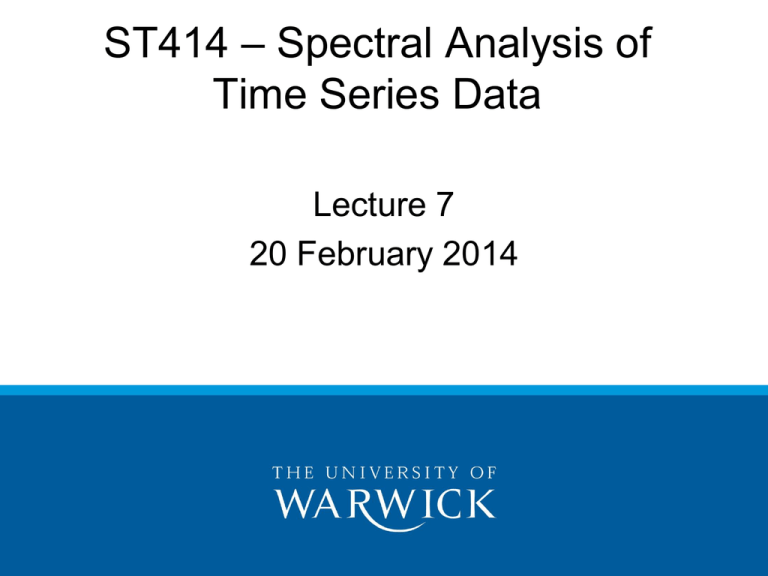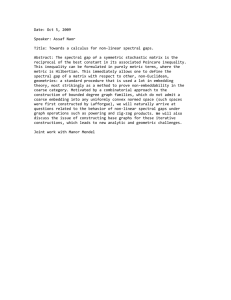– Spectral Analysis of ST414 Time Series Data Lecture 7
advertisement

ST414 – Spectral Analysis of Time Series Data Lecture 7 20 February 2014 Last Time • Asymptotics for the spectral density matrix • Statistical inference for coherence analyses • Estimating VAR parameters • Causality • The VAR spectral density matrix 2 Today’s Objectives • VAR spectral density matrix example • Linear filters • Tapering 3 The VAR Spectrum Recall the spectral density for an AR(p) is 𝜎2 𝑓 𝜔 = , 2 |Φ(exp −𝑖2𝜋𝜔 )| where 𝑝 𝜙𝑗 𝑧 𝑗 Φ 𝑧 =1− 𝑗=1 4 The VAR Spectrum The spectral density matrix for a VAR(p) is 𝑓 𝜔 = Φ(exp −𝑖2𝜋𝜔 )−1 Σ[Φ(exp −𝑖2𝜋𝜔 )∗ ]−1 , where 𝑝 Φ𝑗 𝑧 𝑗 Φ 𝑧 = 𝐼𝑑 − 𝑗=1 5 Sales Example 6 Sales Example 7 Sales Example VAR(2) for Sales/Lead data: 0.280 − 0.730 Φ1 = 0.028 − 0.516 0.205 − 2.177 Φ2 = −0.011 − 0.153 1.431 − 0.022 Σ= −0.022 0.077 8 Sales Example Causality tests: 𝐻0 : Sales does not Granger-cause Lead p = 0.267 𝐻0 : Lead does not Granger-cause Sales p = 1.806 x 10-8 𝐻0 : No instantaneous causality p = 0.422 9 Sales Example 10 Sales Example 11 Sales Example 12 Seasonality Example Suppose X(t) is weakly stationary, sampled monthly. Consider the differenced series Y(t) = X(t)-X(t-12). What is the spectrum for Y(t)? 13 Seasonality Example 14 Seasonality Example 15 Seasonality Example 16 Seasonality Example 17 Seasonality Example 18 Differencing Example This time, consider the first difference: Y(t) = X(t) – X(t-1) What is the spectrum for Y(t)? 19 Differencing Example 20 Differencing Example 21 Moving Average Example Consider now a moving average X(t): 1 𝑌 𝑡 = 𝑋 𝑡−6 +𝑋 𝑡+6 24 1 + 12 5 𝑋(𝑡 − 𝑟) 𝑟=−5 What is the spectrum for Y(t)? 22 Moving Average Example 23 Moving Average Example 24 Moving Average Example 25 Moving Average Example 26 Linear Filters Let X(t) be a weakly stationary process with spectrum 𝑓𝑋 𝜔 , and let 𝜓𝑗 be a 𝑗𝜖𝒁 sequence with 𝑗𝜖𝒁 |𝜓𝑗 | 𝑌 𝑡 = < ∞. Let 𝑗𝜖𝒁 𝜓𝑗 𝑋 𝑡−𝑗 . Then the spectrum of 𝑌 𝑡 is 𝑓𝑌 𝜔 = |A 𝜔 |2 𝑓𝑋 𝜔 , where A 𝜔 = 𝑗𝜖𝒁 𝜓𝑗 exp(−𝑖2𝜋𝜔𝑗). 27 Linear Filters Let X(t) be a weakly stationary P-variate process with spectral density matrix 𝑓𝑋 𝜔 , and let Ψ𝑗 𝑗𝜖𝒁 be a sequence of QxP matrices with 𝑗𝜖𝒁 ||Ψ𝑗 || < ∞, where || ∙ || is any matrix norm. Let 𝑌 𝑡 = 𝑗𝜖𝒁 Ψ𝑗 𝑋 𝑡 − 𝑗 . Then the QxQ spectral density matrix of 𝑌 𝑡 is 𝑓𝑌 𝜔 = A 𝜔 𝑓𝑋 𝜔 A 𝜔 ∗ , where A 𝜔 = 𝑗𝜖𝒁 Ψ𝑗 exp(−𝑖2𝜋𝜔𝑗). 28 Tapering If X(t) is zero-mean weakly stationary with spectral density 𝑓𝑋 𝜔 , one can show that 0.5 𝐸 𝐼 𝜔𝑗 = 𝑊𝑇 (𝜔𝑗 − 𝜔) 𝑓𝑋 𝜔 𝑑𝜔, −0.5 where 𝑊𝑇 (𝜔) is the Fejer kernel. 29 Tapering Let h(t) be a data taper, with DFT 𝑇 𝐻𝑇 𝜔 = 𝑇 −1/2 ℎ 𝑡 exp(−𝑖2𝜋𝜔𝑡) . 𝑡=1 Define 𝑌 𝑡 = ℎ 𝑡 𝑋(𝑡). Then 0.5 𝐸 𝐼𝑌 𝜔𝑗 = 𝑊𝑇 (𝜔𝑗 − 𝜔) 𝑓𝑋 𝜔 𝑑𝜔, −0.5 where 𝑊𝑇 𝜔 = |𝐻𝑇 𝜔 |2 . 30 Example 31 Shumway & Stoffer, 2004 Example 32 Example 33 Example 34


